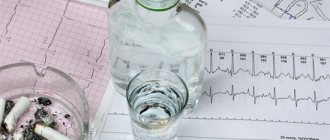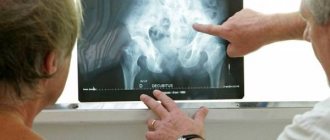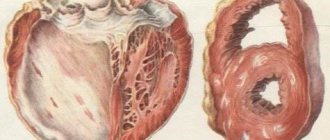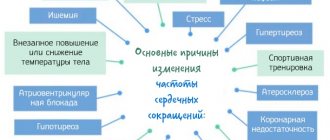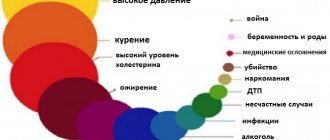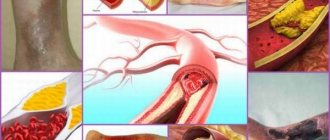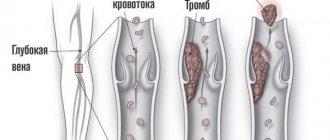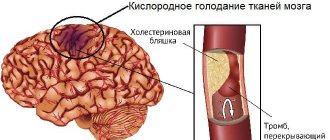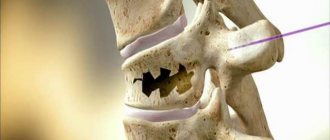A temporary disruption of blood flow through the cerebral vessels can cause the development of a transient ischemic attack. This condition is characterized by the appearance of neurological symptoms of varying severity, which completely disappear within 24 hours after their onset.
Clinical guidelines in neurology recommend using modern laboratory and instrumental research methods to diagnose pathology: computed and magnetic resonance imaging, PET of the brain, ultrasound of the carotid arteries and duplex scanning. Therapy includes the use of antiplatelet, vascular and neuroprotective medications to reduce the risk of ischemic stroke and other complications.
Main reasons
Transient ischemic attack (TIA) is a reversible condition that does not lead to organic brain damage. Among the causes of its development are atherosclerotic lesions of cerebral vessels. Atherosclerosis of intracerebral and extracerebral arteries is detected in 50-60% of patients. Atherosclerotic plaques can independently block the lumen of the carotid, vertebral or cerebral arteries, and can serve as a source of thrombotic masses. The latter, entering the vessel, cause its persistent occlusion, disrupting the blood flow.
In 15-25% of patients, the cause is elevated blood pressure. Long-term hypertension causes structural changes in blood vessels. In some cases, high blood pressure and atherosclerosis are diagnosed in one patient, worsening his prognosis for recovery.
A common cause is cerebral thromboembolism. The source of blood clots is the heart. Thrombotic masses are formed in it during various types of arrhythmias, myocardial infarction, endocarditis, cardiomyopathy, congenital and acquired defects. With abnormalities in the development of the heart muscle, transient attacks of ischemic origin can be detected in childhood.
In addition to the above reasons, the following can lead to TIA:
- inflammatory arterial diseases: Takayasu's disease, antiphospholipid syndrome, etc.;
- dissection of the vascular wall as a result of head injuries and chronic inflammation;
- diabetes mellitus and other endocrine diseases;
- disorders of the blood coagulation system, etc.
In neurology, there are a number of risk factors that contribute to the occurrence of ischemic brain damage:
- high level of total cholesterol in a biochemical blood test;
- smoking and alcohol abuse;
- obesity of any severity;
- low physical activity;
- arterial hypertension;
- diabetes.
If one risk factor is present, the likelihood of a TIA increases by 10%. If there are two or more factors, the risk increases by 30-49%. In this regard, prevention of the development of ischemic attack is based on their correction.
Causes
TIA is not an independent disease; its occurrence is associated with pathologies of the cardiovascular system, blood clotting problems, vascular injury and large blood loss. The causes of thromboembolism are most often associated with:
- atrial fibrillation;
- sick sinus syndrome;
- mitral stenosis;
- atrial fibrillation;
- dilated cardiomyopathy;
- infective endocarditis;
- atrial myxoma;
- acute heart attack;
- thrombosis of the left atrium.
TIA can occur in patients with:
- patent oval valve;
- artificial heart valve;
- mitral valve calcification;
- heart disease;
- heart failure;
- angiopathy;
- coagulopathy;
- abnormalities in the vertebral and carotid arteries.
Classification of pathology
In neurology, 3 classifications of TIA are used: based on the location of the lesion, frequency of occurrence and severity. When examining the bloodstream, doctors distinguish the following types of disease:
- with damage to the carotid arteries;
- with damage to the vertebrobasilar arteries;
- with bilateral and multiple lesions;
- transient cerebral ischemic attack, unspecified.
Depending on the blockage of a particular vascular branch, this classification can be refined. Separately, transient blindness syndrome and transient global ischemia are distinguished.
Based on the severity of clinical signs, the following degrees are distinguished:
- mild - symptoms last less than 10 minutes;
- moderate severity - up to 2-3 hours;
- severe - up to 24 hours.
A common cause of transient ischemic attacks is cerebral thromboembolism.
The frequency of transient ischemic attacks affects the treatment and prevention of ischemic stroke. Therefore, all cases of the disease are divided into three options:
- rare - no more than 2 times a year;
- medium frequency - no more than 6 times a year;
- frequent - more than 6 times a year.
These classifications are used to diagnose the disease in each patient individually. Based on the identified pathology options, treatment and rehabilitation methods are selected.
Symptoms and diagnosis
Typical symptoms of a TIA are listed below:
- Impaired motor function (paralysis or paresis of the facial muscles, upper limb, lower limb);
A standard test that can be performed at the preclinical stage is to ask the patient to smile, raise both arms, and raise both legs while sitting.
- Violation in the sensitive area (half of the body is affected on the side opposite to the lesion, sensitivity may disappear selectively);
Testing the patient - using pricking.
- Cognitive impairment;
The doctor or other person asks the patient to count to 10 and back, say his name, today's date and year, the place in which he is located. Sometimes diagnosis is impossible due to speech impairment;
- Aphasia (inability to pronounce words or understand the speech of another person);
- Disturbance in the functioning of the cranial nerves (paralysis of the facial muscles, ptosis of the eyelids, disturbances in the functioning of the oculomotor muscles).
Symptoms of TIA depending on location:
Occipital lobe (vertebrobasilar region)
Dizziness; Nystagmus; Swallowing problems; Dysphagia; Abnormal blood pressure and pulse.
Temporal lobe (middle and posterior cerebral arteries)
Hemiparesis on the opposite side; Dysarthria; Loss of sensation on the opposite side; Loss of part of the visual field; Ignoring half the space.
Parietal lobe
Loss of the ability to clearly direct your movements towards a specific object; Aphasia (difficulty perceiving words with similar meanings); Inability to count; Reading disorder.
Frontal lobe
Hemiparesis; Confusion; Behavioral disorders; Violation of consistent and logical thinking; Urinary incontinence.
MRI
MRI or CT is mandatory for all patients with signs of stroke or TIA. The results of the study must be presented within 40 minutes after the patient’s admission to the hospital.
What are the objectives of these surveys?
- Identify diagnostic signs that are not characteristic of a stroke or attack (tumor, injury, encephalitis);
- Exclude intracerebral hemorrhage, which is a contraindication for thrombolysis;
- Detection of early signs of ischemia. Of course, conventional MRI modes do not provide information about the presence of TIA. They show changes from a moderate to severe stroke. To diagnose TIA, the DWI (diffusion-weighted imaging) mode is required. Acute ischemia is visible on such tomograms in 20-25% of patients.
What tests are performed for a transient ischemic attack?
In the first 20 minutes upon admission to the hospital, the patient’s blood is taken:
- Blood for sugar;
- Complete blood count with platelet level determination;
- APTT;
- INR.
Hyperglycemia significantly influences the course of stroke. Therefore, blood sugar should be normalized in the first hours of the patient’s admission to the hospital.
Next, doctors conduct the following laboratory tests:
- Blood test with determination of ESR;
- Acid-base ratio in the blood;
- Determination of oxygen (pulse oximetry);
- Urinalysis, hemostasiogram, biochemical analysis, determination of homocysteine and c-reactive protein.
Remember that the onset of TIA is recommended to be considered as a form of stroke. No differences between these pathologies are noticeable in the first hours if the symptoms of TIA are not relieved. Active management of such patients will help save lives and prevent stroke.
Other instrumental diagnostic methods
- A mandatory examination item is an electrocardiogram. It is performed in 12 leads. This is necessary to determine cardiac dysfunction, arrhythmias (fibrillation, heart attack, silent ischemia, angina pectoris);
- Ultrasound duplex scanning of neck vessels, ECHO of the heart (detection of embolism);
- Transcranial Doppler sonography allows us to assess the presence of microemboli in the vessels of the brain.
Consequences
Unfortunately, TIA is a serious pathology. And even after the attack has stopped, the patient has changes. These include:
- Weakness;
- Residual effects in the form of paresis or paralysis in the limbs;
- Impaired sensitivity;
- Problems with speech and memory;
- Depression and swallowing problems.
Clinical manifestations
The main symptom of TIA is neurological impairment that lasts up to 24 hours. Doctors most often learn about the clinical signs of the disease from the patient’s words, since by the time he goes to a medical institution, the symptoms disappear.
Symptoms of transient ischemic attack depend on the location of the lesion:
- TIA involving the carotid arteries most often manifests as visual impairment. The patient may notice a decrease in visual acuity, loss of individual visual fields, or complete blindness on one side. In addition, motor and sensory disorders of the arms and legs of a unilateral nature are often observed. In rare cases, unilateral convulsive syndrome is possible.
- TIA involving the vertebrobasilar region is characterized by disruption of the cerebellum. The patient exhibits a shaky gait, instability in a vertical position, and dizziness of varying severity. Speech disturbances are characteristic, as are motor and sensory disturbances in the legs and arms.
- When the arteries supplying the retina are damaged, a syndrome of transient blindness occurs. It is short-term and affects one eye. In some cases, loss of individual fields of vision is possible. Due to the small diameter of the retinal arteries, cases of TIA are common.
With transient global amnesia, the patient suddenly loses memories of the past. The localization of the ischemic focus is difficult to establish; apparently, a transient disruption of the blood supply occurs in the hippocampus and other subcortical structures. There is a characteristic connection between memory impairment and psycho-emotional stress and severe pain. Amnesia captures small fragments of the past, and after blood circulation is restored, memory is completely restored.
Common symptoms of TIA
During an ischemic attack, characteristic clinical signs appear that will allow the doctor to determine the degree of damage to brain structures and the stage of the pathological condition. Taking into account the symptoms of acute cerebral circulatory disorders, the specialist selects the most effective therapeutic methods.
Common signs of transient ischemic attack (TIA):
| Name | Description |
| Occipital lobe | The victim experiences visual disturbances and hallucinations. The shape and size of objects change. Flickering appears before the eyes. In severe situations, vision is temporarily lost completely. When the cerebellum, which is located in the occipital region, is damaged, severe dizziness occurs. Impaired orientation in space makes a person move less. |
| Temporal lobe | Impaired blood circulation in this area of the brain provokes the appearance of epileptic seizures with convulsions and loss of consciousness. In some cases, doctors diagnose memory loss; rarely, global memory loss occurs. In difficult situations, clouding of consciousness is accompanied by severe hallucinations. |
| Parietal lobe | After an attack, a person cannot read, count, or write. Hallucinations and false tactile sensations appear. It is difficult for a person to recognize objects, even with tactile contact with them. Concentration deteriorates. |
| Frontal lobe | The pathological condition is accompanied by paresis, paralysis, damage to the oculomotor nerves, temporary dementia, and decreased thinking. The patient's behavior is inappropriate and there is severe irritation. Gait, basic reflexes and the sense of smell are also impaired. |
The skin becomes pale and moist. If you ask the victim to touch the tip of his nose with his finger, he will miss.
Complications
In the absence of adequate first aid and subsequent treatment, the patient may develop the negative consequences of a transient ischemic attack. These include the following conditions:
- development of microstroke, characterized by organic damage to small areas of nervous tissue in the absence of clinical manifestations;
- ischemic stroke, which develops if the obstruction of a blood vessel is not eliminated or progresses, while organic changes occur in the brain - nerve cells die, swelling occurs and an inflammatory reaction develops;
- persistent neurological deficit, characterized by persistence of symptoms (the patient may experience impaired sensitivity or motor activity of varying severity);
- cognitive impairment: decreased memory, ability to concentrate, rapid mental fatigue, etc.
A transient ischemic attack increases the risk of developing an ischemic stroke in the future.
Complications can be prevented by promptly seeking medical help and starting complex therapy.
Possible consequences
An ischemic attack is a pathological condition that in some situations occurs without serious consequences. But with constant exposure to provoking factors, the risk of a repeat attack remains.
The likelihood of serious consequences also increases:
| Name | Description |
| General violations | Residual effects are paresis or paralysis of the limbs. General weakness in the body. Problems with speech, memory, depression, impaired swallowing reflexes. |
| Vascular dementia | The disease is characterized by damage to the central nervous system. The functioning of the brain is disrupted, mental disorders appear, which gradually leads to the development of dementia. |
| Dysarthria | The pathological condition is accompanied by a speech disorder, in which it is difficult for a person to pronounce words, sounds, and syllables. |
Microstroke is also a complication of transient ischemic attack. The pathological condition is characterized by organic damage to a small area of nervous tissue. With this disease, there are no pronounced clinical signs.
Diagnostic measures
The diagnosis of “Transient ischemic attack” is made according to a special algorithm and includes various diagnostic approaches:
- Collection of complaints available at the time of treatment, as well as symptoms that the patient noted in the past. These include headaches, dizziness, impaired coordination of movements, changes in speech, weakness and numbness in the arms and legs, etc. When collecting an anamnesis, it is necessary to find out what caused the clinical signs: heavy physical activity, drinking alcohol, emotional stress or the use of medications funds. Concomitant diseases are identified, primarily acute cerebrovascular accidents. Cases of TIA in the past, pathologies of the cardiovascular system and endocrine organs.
- Neurological examination, including the study of sensory, motor function, cognitive skills, etc.
- The list of laboratory tests consists of a clinical blood test, a biochemical blood test with determination of glucose levels, total cholesterol, low and high density lipoproteins, triglycerides, liver enzymes and bilirubin, urea, creatinine and blood electrolytes. According to indications, studies are carried out to identify rheumatic diseases: determination of autoantibodies, LE cells, etc.
- Electrocardiography with ultrasound of the heart in the presence of cardiac pathology.
- Ultrasound of extracranial vessels with Doppler sonography and duplex scanning can detect obstruction of the vertebral and carotid arteries. Methods are necessary to identify atherosclerotic plaques, thrombotic occlusions and vascular aneurysms. To clarify the diagnosis, it is possible to conduct cerebral angiography or MRI examination of the arteries of the brain.
- During the initial examination of the patient, a computed tomography scan of the head is performed to eliminate organic brain lesions (hematomas, intracerebral tumors, etc.). Also, CT can detect ischemic stroke, which can occur similar to TIA. To increase the accuracy of diagnosis and assessment of the condition of the brain, MRI is performed.
- PET (positron emission tomography) evaluates not only the structural integrity of the brain, but also the activity of metabolic processes in the nervous tissue. In specialized centers, this diagnostic method allows one to clarify the nature of ischemia and also identify micro-strokes.
Differential diagnosis of transient ischemic attacks is carried out with ischemic and hemorrhagic stroke, epileptic seizures and the onset of multiple sclerosis.
Diagnostics
All patients who develop a transient ischemic attack are immediately taken to the clinic. Early diagnosis and timely treatment will help “block” the path to stroke. Patients are taken to the neurological department, equipped with the necessary diagnostic equipment.
Clinical examination scheme
The list of mandatory diagnostic methods for transient ischemic attack includes:
- auscultation of the carotid arteries;
- blood pressure measurement;
- blood test with a detailed leukocyte formula;
- blood lipid spectrum: cholesterol and triglyceride levels;
- state of the coagulation system;
- ECG;
- Ultrasound of head and neck vessels;
- electroencephalography;
- MRI with angiography;
- computed tomogram.
Electroencephalography
All patients should undergo examinations, because in the future the consequences can be irreversible and lead to disability or death. The clinical picture of a transient ischemic attack can mask a number of serious diseases.
Differential diagnosis
Some symptoms that characterize the transient course of ischemic cerebral attack are similar to manifestations of other neurological diseases, namely:
- A migraine attack is accompanied by visual and speech disorders;
- After an epileptic seizure, a period of muted consciousness begins with decreased sensitivity;
- Diabetes mellitus is manifested by various neurological symptoms: paresthesia, dizziness, loss of consciousness;
- Multiple sclerosis may debut with TIA symptoms;
- In Meniere's disease, attacks are accompanied by vomiting and dizziness.
After an objective clinical examination and differential diagnosis, you can move on to informed treatment.
How to give first aid
First aid when symptoms of TIA occur is carried out by relatives or colleagues of the patient. First of all, you need to call an ambulance. Over the phone, you should describe in detail the symptoms that have arisen, as well as the reasons for their occurrence. The person is freed from tight clothing and belts, ensuring calm breathing. While waiting for an ambulance, the patient should lie on his back. Place a pillow or folded clothing under your head. It is not recommended to use medications on your own.
Emergency care for transient ischemic attack is provided only by doctors. It is based on eliminating the cause of the disease - lowering blood pressure, restoring respiratory function, etc.
Clinic
Symptoms of a TIA often develop suddenly. They are identical to those characteristic of ischemic stroke, but are temporary and reversible. Their duration usually ranges from 2 to 30 minutes, after which they are completely resolved.
A patient may experience several TIAs in 1 day or only two or three times after several years.
The TIA clinical picture may include the following suddenly appearing signs:
- Weakness or paralysis on one side of the body (for example, half the face, one arm or leg, or all of one side)
- Loss of sensation or abnormal sensations on one side of the body
- Difficulty speaking (eg, slurred speech)
- Confused, difficult to understand speech
- Darkening, blurriness, or loss of vision, especially in one eye
- Dizziness or loss of balance and coordination
Clinical evaluation of a possible TIA involves careful examination of the onset, duration, fluctuation, location and severity of symptoms. A review of the patient's medical record is required, which is extremely important to identify dysfunction from previous strokes, seizures, or heart attacks.
Clinical manifestations will vary depending on the vessel involved and the size of the brain region it supplies.
Initially, emergency situations that can simulate TIA are excluded:
- Hypoglycemia
- Tumor or mass lesion
- Migraine with aura
- Peripheral nerve disorder
- Demyelinating disease
- Vestibular dysfunction
- Intracranial hemorrhage
- Electrolyte disorders
A TIA can last several minutes, and symptoms often disappear before the patient is seen by a doctor. Thus, questions related to medical history are often asked not only of the patient, but also of family members, witnesses, or emergency medical personnel.
Video Transient cerebrovascular accident
Treatment approaches
Treatment of transient ischemic attack is a complex task aimed at preventing the development of stroke and restoring the functions of the nervous system. For this purpose, non-drug therapy and medications are used.
Various groups of drugs are used as drug therapy to eliminate the causes of TIA and prevent its complications. Treatment should be aimed at restoring blood flow through the cerebral arteries. It is recommended to use antiplatelet medications (Dipyridamole, Clopidogrel or Acetylsalicylic acid). In addition to antiplatelet agents, indirect anticoagulants (Phenindione, Ethylbiscoumacetate) can be used. The use of direct anticoagulants (Heparin, Fraxiparine, etc.) is contraindicated due to the risk of internal hemorrhages. Intravenous administration of glucose and combined saline solutions is necessary to improve the rheological properties of blood.
When the disease develops against the background of arterial hypertension, drugs that lower blood pressure come to the fore. The drug of choice is Captopril, which belongs to the group of ACE inhibitors. In addition, it is possible to use aldosterone receptor antagonists (Candesartan, Eprosartan), as well as beta-blockers (Esmolol, Propranolol). To improve cerebral circulation, Cinnarizine, Vinpocetine, Actovegin, etc. are prescribed.
An important stage of therapy is the prevention of the death of nerve cells associated with metabolic changes against the background of ischemia. The following drugs can be used as neuroprotective therapy:
- Magnesium sulfate;
- Glycine;
- Piracetam;
- Cytoflavin et al.
Treatment of TIA also includes symptomatic treatment. If vomiting develops, use Cerucal or Ondansetron. For headaches, Indomethacin, Ibuprofen, etc. are prescribed. Any medications should be used only after being prescribed by the attending physician, as they have contraindications. Otherwise, progression of the underlying disease or development of side effects of therapy is possible.
Non-drug methods
As a non-drug treatment, the patient must remain in the neurointensive care unit for 6 hours. During this period of time, he is under constant surveillance. The use of physiotherapeutic methods (oxygen barotherapy, electrosleep, microwave exposure) can improve metabolic processes in the body and have a positive effect on overall health.
In case of severe vascular occlusion, detection of large atherosclerotic plaques or aneurysms, surgical interventions may be performed to eliminate them. Operations are carried out after hospitalization and a comprehensive examination. Surgical interventions eliminate the cause of transient ischemic attacks, preventing their occurrence in the future.
Treatment
For a transient attack that has not yet ended, the patient’s treatment fully complies with the standards of stroke management. If more than 12 hours have passed since the end of the attack, the ambulance must hospitalize the patient. The risk of recurrent attacks is quite high.
If 48 hours have passed since the TIA, doctors may recommend outpatient follow-up examination. But it is carried out only for minor attacks (less than 1-2 minutes) with complete restoration of function. And if there is a possibility of hospitalization, then it is better not to refuse it. Observation for 2-3 days and further examination (MRI, ECHO-kg, ultrasound scan) is effective in case of attacks. After all, the likelihood of a recurrence remains for another 3 months.
Urgent Care
From the first minute of an attack, a patient with a TIA or stroke needs hospitalization. This requires transportation to a medical facility by an ambulance. What can be done before the doctors arrive?
- Lay the patient on his side, head higher than feet, unbutton tight clothing;
- Provide access to oxygen, open doors and windows in the room;
- Measure blood pressure, pulse, and inform the arriving team about changes;
- If the patient is conscious, ask about chronic diseases and medications that he takes constantly. Tell the arriving doctors about everything.
First medical aid is to support important systems for the body. The team measures blood pressure and takes a cardiogram. If problems of the cardiovascular system are detected, their correction is required. After all, it is the heart that supplies blood to the brain.
Blood pressure is lowered, antiarrhythmics are given, and the angina attack is stopped. Pulse oximetry is performed. If the oxygen content is insufficient, additional oxygenation is required. Additionally, blood glucose is monitored, which also requires correction at the prehospital stage.
Call card
A typical example from life that accurately illustrates the course of a transient ischemic attack.
A call was received at the ambulance station: patient M., 68 years old. Complaints of numbness in the right arm and leg, difficulty speaking.
History: the patient felt a deterioration in health after 17.00. I measured my blood pressure – 190/100 mmHg. She associated the deterioration with an attack of hypertension, and took a pill (moxonidine) on her own. An hour later, the condition had not improved, the relatives called the joint venture.
Such a patient should be taken to the hospital for observation and further examination. At this stage, it is unclear whether neurological symptoms will worsen. Or the clinical symptoms will disappear.
Conservative treatment
Most often, TIA symptoms go away without leaving significant consequences. In this case, the treatment regimen uses:
- Antiplatelet agents (aspirin 100 mg) and anticoagulants (if necessary);
- Statins (atorvastatin);
- Drugs to lower blood pressure;
- Medicines to normalize sugar (for diabetes).
Prevention of TIA is protection from stress, control of arterial hypertension and diabetes, giving up bad habits, and increasing the level of physical activity. For residual effects, the following types of medications are used:
- NMDA receptor modulators;
- Nootropics (citicoline);
- Vascular drugs;
- Antioxidants;
- Cell membrane stabilizers.
Surgical treatment
Transient ischemic attack is a pre-stroke condition. However, with it, the clinical symptoms of the disease disappear within 24 hours from the onset of the attack. Therefore, no surgical interventions are performed for TIA.
However, if after examination the patient is found to have signs of an ischemic or hemorrhagic stroke, then surgical treatment may be required. But this is possible only after examination and diagnosis of stroke.
Any changes in the vessels during TIA (carotid system plaque instability) that require surgical treatment are carried out routinely after the patient has been stabilized.
Prevention
What can you do to protect yourself and your family from transient ischemic attack? Let's dwell on the basic but important points of TIA prevention:
- Quitting smoking (nicotine is a powerful factor in the progression of vascular atherosclerosis);
- Replacing excess animal fats with vegetable fats (sunflower oil, olives, nuts). It is known that saturated fats cause growth and instability of atherosclerotic plaque. But polyunsaturated oils make it more plastic and elastic;
- Diversify your diet with fresh fruits and vegetables. They are an important source of vitamins and microelements necessary for health;
- Avoid or minimize alcohol intake. If for a stroke doctors allocate a “safe” dose of ethyl alcohol (one standard dose per day), then for colon cancer any use will provoke tumor growth;
- Do not use excess salt in food. Salty foods cause an uncontrolled increase in arterial hypertension and edema;
- Regular physical activity. You should do 30 minutes of any aerobic exercise 3-4 times a week. Monitoring pulse and well-being is mandatory;
- Control your body weight;
- Normalize your blood sugar levels.
A transient attack with a favorable outcome is only a warning about the presence of a serious pathology. Be sure to undergo a full examination and follow preventive recommendations. And then serious consequences can be avoided.
Rehabilitation
Patients with TIA need rehabilitation measures aimed at restoring brain function. Rehabilitation is based on the following influences:
- Physiotherapy. The exercises are aimed at developing the motor functions of the arms, legs and facial muscles. Exercise therapy classes are conducted under the supervision of a specialist.
- Physiotherapeutic effects (electrophoresis, magnetotherapy, electrosleep, etc.) have a positive effect on the general condition of the patient.
- Massotherapy.
Long-term rehabilitation for transient ischemic attacks is not required, since brain functions recover independently. However, with frequent episodes, these rehabilitation measures can improve the patient’s quality of life.
Causes of transient ischemic attack
First, you need to consider what it is - TIA, since an ischemic attack is not an independent disorder. Pathology is a consequence of changes in the condition of blood vessels, blood flow, dysfunction of the heart muscle or a number of other organs in the blood supply system.
The development of TIA is reversible; accordingly, the decrease in blood flow to the brain goes away over time. The main reason is the formation of a blood clot, which clogs the vessel and blocks normal blood flow, but the blockage is incomplete, part of the lumen remains. Hypoxia of brain tissue leads to disruption of its function.
The consequences of an ischemic attack of the brain are life-threatening only in severe forms of the pathology, in other cases it goes away on its own, but each attack is a health risk. Over time, a clot can develop and completely block blood flow, leading to a heart attack or stroke.
The condition of the blood vessels plays an important role in the genesis of TIA, since the risk of an attack increases in the event of vascular spasms or deterioration of blood flow and thrombophilia. An additional predisposition factor is a decrease in cardiac output; due to insufficient cardiac muscle function, blood flows poorly to some areas of the head.
TIA develops quickly and has an acute course. The condition is characterized by a short-term focal disorder, sometimes with cerebral damage. The condition can be confused with a stroke, but its characteristic difference is its short-term course, usually after 1 hour the symptoms disappear. Mostly, the duration of an ischemic attack ranges from 5 minutes to 24 hours.
The difference between TIA and stroke
Often an ischemic attack of the brain is a consequence of:
- atherosclerotic disorders in the condition of blood vessels;
- hypertension;
- cardiac ischemia, including myocardial infarction;
- atrial fibrillation;
- installation of a prosthetic valve in the heart;
- dilated cardiomyopathy;
- diabetes mellitus;
- various disorders of the vascular system: the onset of collagenosis, vasculitis, arteritis;
- antiphospholipid disorder syndrome;
- aortic coarctation;
- congenital or acquired tortuosity in the vessels of the head;
- genetic underdevelopment of the vascular system of the head;
- osteochondrosis in the cervical region.
Physical inactivity (a person leads a passive lifestyle) and habits that are detrimental to vascular health can provoke the appearance of an ischemic attack. For the cardiovascular system, the most harmful habits are smoking and alcoholism.
Preventive actions
Primary includes the elimination of correctable risk factors:
- Timely treatment of arterial hypertension using modern antihypertensive drugs.
- Quitting smoking, drinking alcohol and drugs.
- Therapy of diseases of the heart and blood vessels.
- Correction of lipid metabolism disorders with changes in diet and medications.
- Treatment of diabetes mellitus.
It is recommended to regularly engage in physical activity, normalize body weight and limit salt intake. Women with the above risk factors should not use oral contraceptives, which increase the risk of ischemic disorders.
Secondary prevention of TIA is aimed at preventing the recurrence of ischemic attacks. For this purpose, the patient must follow the doctor’s instructions for lifestyle changes, as well as use prescribed medications to correct concomitant diseases of the cardiovascular, endocrine and other systems. The patient is prescribed lipid-lowering therapy, antithrombotic and antihypertensive drugs.
Symptoms of the attack
With ischemic damage, the symptoms largely depend on the location of the damaged vessels and tissues. In neurology, there are 2 clinical pictures: general cerebral and local.
The first is manifested by dizziness and headaches that are paroxysmal in nature. The patient feels nauseous and feels weak in the limbs. Some people may faint for a short period of time.
The second has more specific manifestations. They depend on the location of the lesion and will always be typical for certain areas of the brain. Using them, you can determine the form of a transient attack in a particular patient.
The intensity of symptoms allows doctors to distinguish 3 degrees of attack severity:
- Easy. The duration of the attack does not exceed 10 minutes.
- Average. Signs may persist for up to several hours.
- Heavy. The attack lasts up to a day. However, mild symptoms may persist for the next few days.
TIA has specific warning signs that can help identify an impending attack. These include:
- Unmotivated headaches.
- Sudden onset of dizziness.
- Eye problems: cloudy veil and floaters.
- Numbness in certain areas of the body.
The attack itself begins with a headache, which quickly intensifies and is localized in a certain area. Then dizziness and nausea come, and vomiting is possible. It becomes difficult for a person to think and cannot navigate the terrain. Confusion appears.
As a rule, ischemic attacks are localized in two vascular territories: carotid and vertebrobasilar. The first supplies the hemispheres of the brain and is responsible for movement, writing, memory and speech, while the second provides blood flow to the brain stem and is responsible for breathing and circulation.
TIA in the carotid region
Acute symptoms appear in just a couple of minutes. Poor circulation in the carotid artery leads to the following disorders:
- Loss of ability to move limbs. Most often, paralysis occurs on one side of the body, and either one or both limbs can become immobilized. In rare cases, the patient's entire body becomes paralyzed.
- Impaired sensitivity and mobility of the facial muscles. The problem becomes noticeable when the patient is asked to smile: an asymmetry in the elevation of the upper lip is revealed. If the patient tries to raise his eyebrows, unequal wrinkles will appear on his forehead.
- Problems with sensitivity in the whole body or in one of its halves, and the border always runs along the line from the tip of the nose to the navel.
- Inability to speak normally. Speech becomes slurred, and the ability to understand what other people are saying is lost. The patient looks frightened and tries to actively communicate with the doctor, but his words have no connection with each other. In some cases, the patient realizes that he cannot pronounce words correctly. Then he tries to keep conversations to a minimum.
- Visual impairment. They can manifest themselves in different ways. Some patients have problems with the mobility of the eyeballs, while others develop strabismus. Blindness is also possible. It involves one or both organs of vision.
- Decreased intellectual abilities. The patient has difficulty with simple counting, has poor spatial orientation, does not know what time of day it is, etc.
Almost all victims have problems with higher nervous activity. They are unable to read the simplest text; they see words and letters in it randomly mixed. When trying to write, patients confuse letters and whole syllables.
Circulatory disorders in the vertebrobasilar artery
The patient has vestibular ataxia and cerebellar syndrome. The person notes that he cannot walk firmly. The resulting dizziness is accompanied by increased sweating.
A transient ischemic attack in the vertebrobasilar region is accompanied by severe headaches localized in the back of the head. At the same time, it seems to the patient that the world is spinning around him, the person tries to grab onto objects in an attempt to maintain balance, and he does this regardless of the position of the body.
When walking, the patient sways strongly from side to side. When he tries to do something with his hands, he looks clumsy. All movements are too sweeping and imprecise.
Visual impairment occurs. The patient sees flashes of light before his eyes. He has lost parts of his visual field and has double vision.
Due to fluctuations in blood pressure, patients often experience temporary memory impairment. Some victims are unable to swallow.
Patients appear pale and their skin is moist. With TIA in the VBB, they exhibit involuntary eye movement along the horizontal plane. If you ask the patient to reach his fingertip to his nose, he will not be able to do this.
Forecast
The prognosis is determined by the severity and frequency of transient ischemia. If the symptoms are mild and occur up to 2 times a year, then the pathology does not have a significant impact on the duration and quality of life. With more frequent TIAs and attacks of moderate severity, the patient's risk of developing organic brain damage increases significantly. In this case, a person needs a comprehensive examination to identify the causes of ischemia (atherosclerotic plaques in the cerebral vessels, congenital malformations of the arteries, etc.) and their elimination.
With severe severity of transient ischemic attacks or frequent disorders of moderate severity, life expectancy is reduced due to the risk of developing ischemic stroke. It is important to note that in each case of a transient attack, the doctor must determine whether it is a microstroke or not. Micro-strokes lead to impairments in a person’s personality and intelligence, and are also a risk factor for stroke.
Diagnosis of TIA
If pathological changes appear, it is recommended to immediately consult a doctor. If you suspect a TIA, you should consult a cardiologist, neurologist and ophthalmologist.
Since the symptoms of transient ischemic attack are short-lived, the disease is diagnosed based on an examination of the patient, his medical history and neurological status.
To identify the cause of pathological disorders and assess the risk of stroke, the doctor prescribes the following diagnostic measures to the patient:
- clinical examination (measurement of blood pressure, blood test, urine test, blood test for cholesterol, glucose, etc.);
- hardware examination (ECG, CT or MRI of the brain, X-ray of the lungs, angiography, daily monitoring of blood pressure, pulse oximetry).
Medical and social examination
The duration of disability depends on the severity of the pathology:
- for mild short-term disorders - up to 2-3 weeks;
- moderate severity - 3-4 weeks;
- severe and frequent attacks of TIA - up to 2 months.
In case of repeated severe crises or frequent TIAs of moderate severity, the patient may be assigned disability group III. If severe crises occur frequently against the background of progression of the underlying disease, then disability group II may be assigned.
You may also be interested in:
Principles of treatment of transient ischemic attacks
Treatment should be started as soon as possible after symptoms are detected. The patient requires prompt hospitalization. Doctors may prescribe:
- antiplatelet agents to improve blood flow - used in the first few days. Acetylsalicylic acid is most often prescribed; the daily dose is 325 mg. After 2 days, the dosage is reduced to 100 mg. Treatment can be supplemented with Clopidogrel and Dipyridamole;
- lipid-lowering agents – “Simvastatin” and “Atorvastatin”;
- nootropic drugs are administered by drip. Popular are Cerebrolysin and Piracetam;
- Anticoagulants prevent the formation of blood clots. Drugs – “Fraxiparin” and “Clexane”;
- treatment with infusion agents, which are used by the drip method. Pentoxifylline and Reopoliglucin are more often prescribed;
- neuroprotective drugs are administered by drip. Well-known names are “Actovegin” and “Cerakson”;
- antioxidants are used in most treatment regimens, Mexidol and Cytoflavin are more common;
- means for restoring blood pressure - “Amlodipine” and “Lisinopril” (or combination drugs “Equator”);
- Insulin therapy for hyperglycemia.
Treatment for TIA should begin immediately
